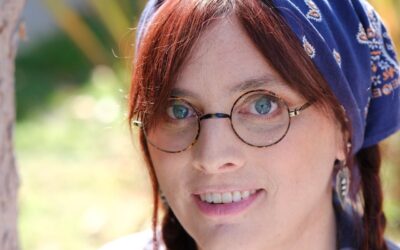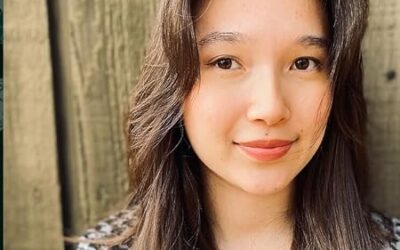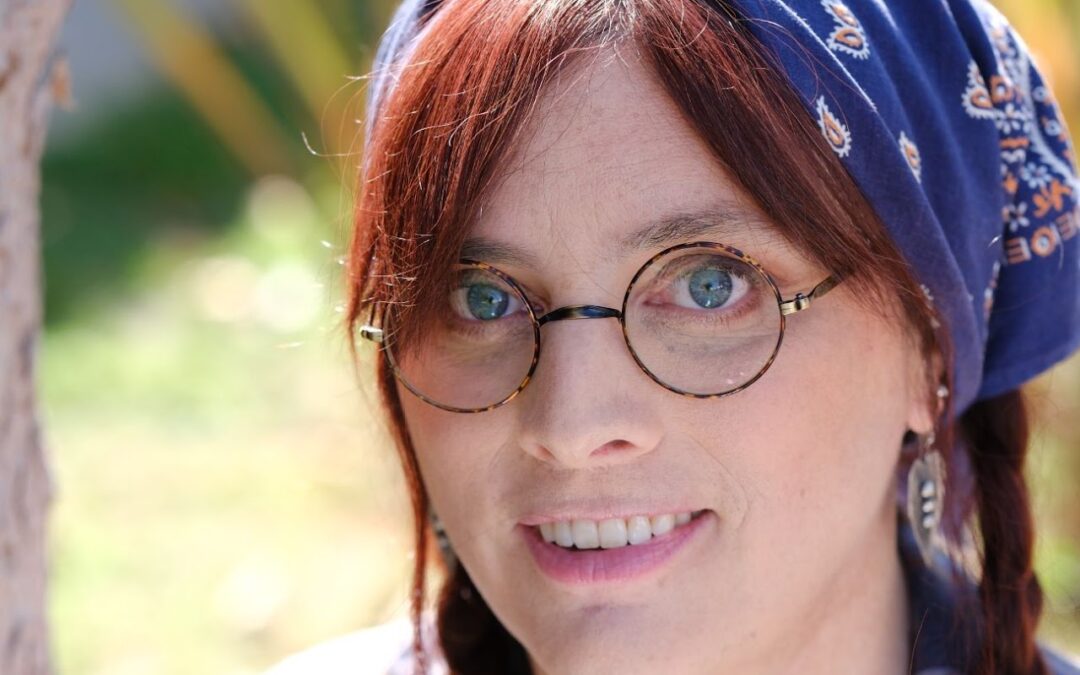Venessa Vida Kelley is a Nuyorican author, illustrator, and aspiring mermaid who writes fairy tales about the real world so they can draw them too. They hold a BA and MA in English literature with concentrations in film from the University of Delaware and the George Washington University, respectively, and their illustrations have decorated LGBTQ+ books worldwide. Venessa lives in Washington, DC, with their spouse, two sons, and an overabundance of teacups and washi tape.
I had the opportunity to interview Venessa, which you can read below.
First of all, welcome to Geeks OUT! Could you tell us a little about yourself?
Thank you so much for having me! I’m Venessa Vida Kelley, an author-illustrator based in the Washington, DC area, and while I suppose I might be best known for my LGBTQ+ and BIPOC romance art and cover illustration work, my first original written and illustrated work will be published this April. I’m beyond excited.
What can you tell us about your book, When the Tides Held the Moon? What was the inspiration for this story?
When the Tides Held the Moon is a fully illustrated adult queer historical romantasy set in 1911 at a Coney Island amusement park sideshow. It stars an Afro-Puerto Rican ironworker named Benny who receives a commission to build a massive iron tank enclosure, then gets roped by the sideshow proprietor into kidnapping its intended inhabitant: a merman from the East River. Through some magical circumstances, Benny is compelled to care for this creature and takes up residence with the sideshow performers as their new co-worker, eventually cultivating a rare kinship with the merman who he names “Río.” It’s a fairy-tale romance, but it’s also very much about freedom and identity and striving for agency in a world that prefers relegating the “other” to the margins.
Inspiration-wise, it all germinated from a sketch. MerMay is an annual online event where illustrators draw and celebrate merpeople for fun, and though I hadn’t originally planned to participate in 2020 during the thick of COVID, this image materialized in my head of a merman and his human lover in 1910s clothing, sharing a kiss through the viewing pane of a tank. From there, the entire beat sheet seemed to fall out of the sky right into my brain.
As a writer, what drew you to the art of storytelling, particularly speculative fiction, historical fiction, and romance?
I’ve been a lifelong fairy tale enthusiast, but I think the draw to romance comes from having generally been sensitive to injustice since I was a kid. Being mixed race in the Puerto Rican diaspora and growing up in the diverse communities of Long Island and New York City placed me at a cultural intersection where privilege and oppression played out before my eyes, not just in my own life, but in the lives of my friends and family. When you bear witness to those inequities enough, I think it cultivates a thirst for the satisfying resolutions you get in romances — the bad guys get their karmic boomerang, the couple gets to live happily ever after.
The attraction to historical speculative fiction happened more recently, when I really began to examine my identity within the context of my cultural heritage and America’s tangled history with Puerto Rico. I felt like I was peeling the vellum off a pretty painting and discovering all this unsavory complexity underneath. Suddenly all the generational trauma in my family had a context, and I could see the way all our lives as an American collective were still caught in the harmful web of colonialism and oppressive power structures. It made me want to write about my ancestors — the sort of people the history books erased. Show how they fought and won their own happy endings, with an added sheen of fantasy for the sheer joy of it.
What drew you in to merfolk?
I was a kid in the ‘80s, so naturally I was obsessed with “The Little Mermaid” and fascinated by “Splash” (thankfully all the sexual content in that movie went straight over my head when I was little!). Coming back to the obsession as an adult was possibly motivated by longing for the innocence of my youth, but I really think it was more to do with the way I was looking for more communion and connection with the world outside my door. I started researching and writing Tides during the COVID lockdown, which influenced my depictions of Río and his merfolk culture as free, fluid, and spiritually connected to one another via the element they’re immersed in.
While I was researching the book, I fell down the rabbit hole of mermaiding as a hobby and as a professional danger art, and this entire world opened up where people of all body types, sexual orientations, races, genders, and abilities could put on a tail and be merpeople! Those who do it professionally free dive with marine animals, holding their breath for minutes at a time, projecting this aura of absolute and total peace in the water. I’ve been able to try my hand (fin?) at it, and the feeling is unreal. That sensation of inner peace and freedom is everything Benny ever wanted.
How would you describe your writing process?
For me, it’s a kind of spiritual practice. I have an ofrenda, which is a little altar where I keep photos, trinkets, candles, and anything else I consider inspiration pertaining to the project. I’ll light a candle, close my eyes, and try to set my intention for the day’s writing without drawing too firm a boundary around what I’m hoping to accomplish. After that, it’s a matter of trying to follow the breadcrumbs. I do have a very basic outline going in, but so much of what I create shows up the moment I get quiet, put up an antenna, and just receive.
What are some of your favorite elements of writing? What do you consider some of the most frustrating/challenging?
My favorite thing is to luxuriate in the vibes of a scene. My education is in film adaptations of literature, so I like to write as though I’m filming a movie, sketching character designs, assembling musical soundtracks, illustrating concept art of key moments to provide visual references for the emotional note I’m trying to hit. I like to immerse myself in the universe I’m writing about.
As for what’s frustrating, writing historical fiction responsibly can be really difficult when you’re trying to tap into marginalized histories. While I find research generally fun and fascinating, you do hit brick walls from time to time from a lack of documentation, and sometimes that results in long nights staring at grainy scans of newspaper articles from 1904 with nothing to show for it.

As a writer and illustrator, who or what would you say are some of your greatest artistic and creative influences and/or sources of inspiration in general?
As a writer, my books are tied to my identity as a queer Latine. So I’ve been looking to my own Latinx author community for inspiration, not only from the standpoint of craft, but for courage as well. It felt so exposing to put what amounts to personal self-exploration in print, and I’ve gotten a lot of motivation and comfort from reading books by such Latine authors as Esmeralda Santiago, Marisel Vera, Quiara Alegría Hudes, Alexandria Villasante, NoNieqa Ramos, Mía Garcia, Elizabeth Acevedo, and Aiden Thomas. I’ve also found inspiration in the speculative works of N.K. Jemisen, Ursula K. LeGuin, TJ Klune, Freya Marske, and Bethany C. Morrow, and for the romance component, Casey McQuiston, Alexis Hall, and Becky Albertalli among many other queer romcom masters have undoubtedly rubbed off on me!
As an illustrator, the most obvious influences in my art come from animation— Disney, Studio Ghibli, Dreamworks, Pixar — because animation marries all my favorite things about film and photography while managing to achieve a level of expressiveness I’m constantly aspiring to as an artist. For WHEN THE TIDES HELD THE MOON in particular, though, I sought inspiration in the works of early 20th Century art nouveau artists like Alfonse Mucha and Saturday Evening Post illustrators J.C. Leyendecker and Norman Rockwell whose works really defined the aesthetic of that era. I also studied the work of Charles Dana Gibson and Franklin Booth hoping to bring some of their iconic 1910s flavor to the interior pen and ink illustrations I created for the book.
Aside from your work, what are some things you would want others to know about you?
I suppose the most interesting thing is that I’m a musician! I’m a classically trained Soprano, play a mess of instruments, and when I have time, I try to spend it songwriting. So far, a lot of the fiction I’ve written incorporates some kind of musical element because I genuinely can’t help myself.
What’s a question you haven’t been asked yet but that you wish you were asked (as well as the answer to that question)?
I wish someone would ask me what sets this captive merperson romance apart from other merperson stories in our popular culture, because on the surface (ha, no pun intended) it might seem Iike When the Tides Held the Moon could just be a rehash of the familiar tropes. But I wrote it because there was an angle with mermaid stories that I hadn’t yet seen explored, even though it seemed like it should have been an obvious one: why has pop culture never apprehended merfolk-lore from the standpoint of post-colonial hybridity?
Hybridity in its crudest, briefest definition is the experience of being culturally neither this nor that because you belong to two worlds. The whole reason Benny connects to Río is because the merman, being half-fish and half-man, is the biological expression of the duality Benny feels as an immigrant — except Río is a fully integrated being. He knows himself and inhabits his body in a way that Benny has found almost impossible because his geographic displacement has fractured his sense of self.
So as much as the book is about a romance between an iron worker and a captive merman, it’s also about self-acceptance and integrating the patchwork of your cultural identity into something whole, whether or not society is accepting of it.
What advice might you have to give for any aspiring writers?
A lot of authors extol the virtues of reading to become a better writer, and while I agree with that wholeheartedly, I also think it’s important to live your life and absorb as many experiences as you can. I’ll be 44 by the time my debut novel publishes, and for a long time, I thought I had squandered my opportunity or missed my chance to write for an audience by allowing myself to detour into occupations that weren’t in obvious alignment with my creativity. Only now do I realize how much I gained by letting myself live all those other lives first. It’s given me a wealth of knowledge I can now put to use in my stories.
So yeah. Live your life. Be patient, stay present, and bless your mistakes. Because it all informs the craft.
Are there any other projects you are working on and at liberty to speak about?
Right now, I’m actually working very hard on completing a graphic novel, Manu Faces the Music, which is slated to release next year with Oni Press. It’s a queer urban fantasy about a young Nuyorican music producer who discovers that her “platinum touch” is a byproduct of being a spiritual lightening rod — a super medium whose third eye was closed as a child. When a rash of arson erupts in the New York barrio she left behind, she winds up having to reactivate her metaphysical powers to save the community that raised her. There’s a lot of action, a smoldering sapphic romance, and again, New York/Puerto Rican heritage woven into the story, and I’m SO excited about it.
Finally, what books/authors (LGBTQ+ or otherwise) would you recommend to the readers of Geeks OUT?
I want to especially highlight BIPOC authors, whose works often get pushed to the back of the bookstore chains or otherwise denied marketing support from publishers. Any of the authors I listed as influences are worthwhile reads, and you can further “desegregate” your fantasy TBR list by adding books by Zoraida Córdova, Nalo Hopkinson, Kacen Callender, Sher Lee, Bethany Baptiste, Shelley Parker-Chan, Justinian Huang, and Kimberly Lemming!







0 Comments